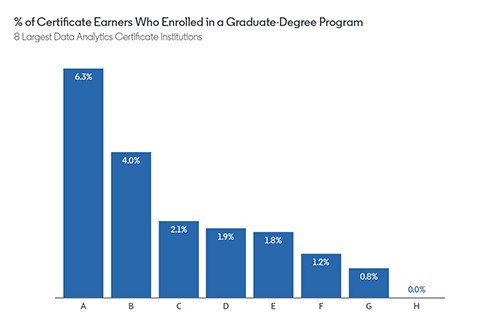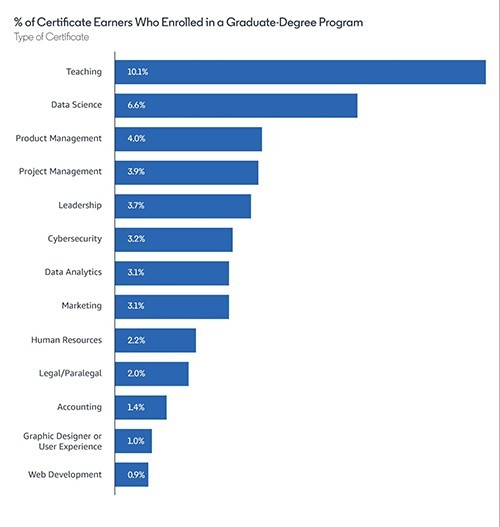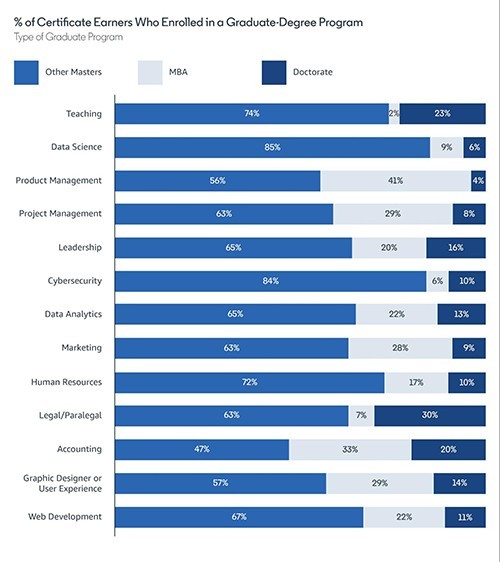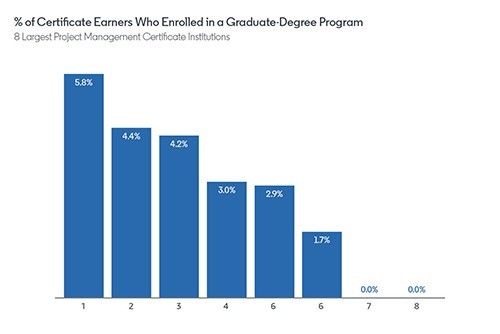Are Certificates Taking Students Away from Graduate-Level Programs?
The last few years have seen an explosion of new ways for people to obtain education beyond a bachelor's degree. Answering the demand from students for programs that are flexible, convenient, and focused on specific skills, higher-education providers have created a wide variety of new offerings, ranging from traditional, advanced degrees to stackable degrees and certificates.
Perhaps no category has grown as quickly as certificate programs. There’s wide consensus that they are increasingly popular and the creation of new certificate programs shows no signs of slowing down. Credential Engine estimates that, in 2021, nearly one million unique credentials are offered in the U.S.
Credential programs can also be profitable for the institutions that offer them. After all, a certificate can generate additional revenue at a low, marginal cost. Many certificates are based on classes that already exist as part of a degree program. Leveraging existing staff and course content to offer an in-demand certificate is clearly an attractive proposition.
But the rise of certificate programs also raises an interesting question for institutions: Are people who earn a bachelor’s degree followed by a certificate more likely to call it quits or continue on to graduate school?
LinkedIn members share their educational histories on their profiles, so we have a unique opportunity to answer this question.
To start, we selected U.S. members who had a bachelor’s degree and, later, earned a certificate. We then looked to see if they enrolled in a graduate program up to two years after earning their certificate. (Details on our methodology provided below.)
So what’s the likelihood that a LinkedIn member, who earned a bachelor’s degree and a certificate, will enroll in graduate school? How does it compare to the national average of 4%, which is the percentage of people with BA degrees who enroll in grad programs each year?
Earning a certificate is a path to grad school, but it depends on the certificate
We found that some certificates predict a higher chance of enrolling in a graduate-degree program, while other certificates predict a lower chance (see chart below).
For example, 10% of LinkedIn members who earned a teaching certificate, later, enrolled in a graduate-degree program. And 7% of members who earned a data science certificate also continued on to graduate school.
Some programs, however, saw fewer than 2% of their certificate-earners enroll in a graduate-degree program (e.g., accounting, graphic design or user experience, and web development).
MBA programs are a popular next step after earning a certificate
After earning a certificate, people enrolled in a variety of graduate programs. With a few exceptions, MBA programs accounted for at least 20% of the graduate programs people enrolled in (see chart below).
MBA programs were least popular among people who earned a teaching, data science, cybersecurity or paralegal certificate.
Doctoral programs were most popular among people who earned a legal, teaching or accounting certificate.
Likelihood of graduate school enrollment also depends on who offered the certificate
There were big differences between certificate institutions, with some seeing a much higher percentage of their certificate-earners heading to graduate school.
The chart below illustrates these differences among the largest institutions that offered data analytics or project management certificates:

This large difference in graduate school enrollment can also be seen among the largest project-management certificate programs (top chart). After earning this certificate, graduate-school enrollment ranged from 0% to 6% across the institutions.
Conclusion
Higher education institutions shouldn’t ignore students who’ve earned a certificate after their bachelor’s degree. These students haven’t hit an educational dead end. In fact, earning a certificate in certain fields and from certain institutions can signal a much higher likelihood of enrolling in a graduate program compared to the national average.
Methodology: Our analysis is based on 22,015 US LinkedIn members who, according to their profiles, earned a BA degree before 2018 and, then, between Jan 2018 and Mar 2019, earned a certificate. We focused just on 13 different types of certificates (teaching, data science, etc.). We excluded members who had already earned a grad degree before their certificate. Lastly, we then looked at the percentage of these “undergrad degree + certificate” members who, within 2 years after earning their certificate, enrolled in or completed a graduate-degree program.
Learn why higher education marketers love LinkedIn and subscribe to the LinkedIn Marketing Solutions blog to keep up with Education Marketing trends.








